What is Suspension System in Automobile?
Suspension System is one of the Mechanical Components of Automobile (Two-Wheel Drive or Four-Wheel Drive or more), which depends upon the dynamics of the whole system working. It is the combination of Tire, Spring, Shock Absorbers, Damper, and Linkage that are used to absorb the vibrations, and shocks; additionally, it helps to achieve the steady moment of vehicle (while pitching and rolling), better handling, comfort journey, and smooth riding experience to the passengers.
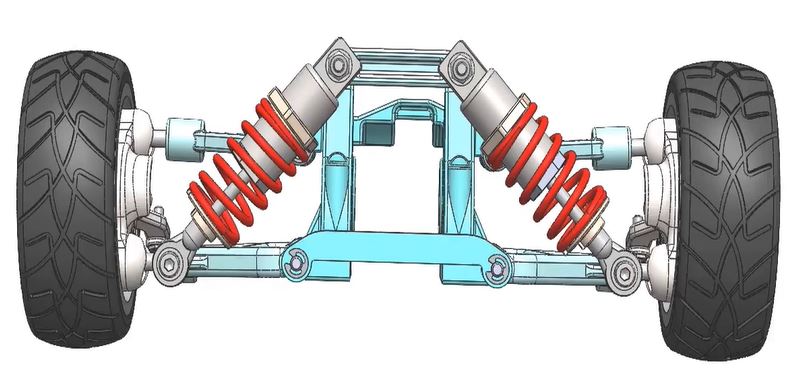
Suspension in Automobile plays vital role in every moment while in motion and motionless. It absorbs all type of forces caused by any rough patch present in the road such as potholes, stone or any other object. Since the spring in the suspension absorbs the forces, they are not transferred to the chassis, which prevents it from bearing unnecessary stress. We can see Suspension System both in Two Stroke Engine and Four Stroke Engine Automotive.
Also Read:
- Four Stroke Engine – Parts, Working, Advantages, Disadvantages, Applications – And More
- Two Stroke Engine- Parts, Working, Advantages, Disadvantages, Applications – And More
The Main objective of Suspension System in Automobile are as follows:
Every component or device in Automobile consists its individual objectives. So, the main objectives of Suspension in Automobile are
- Maximize the Friction between the Tires and Road.
- Provide Steering Stability.
- Provide Comfort and Smooth Riding experience to the passengers and drivers.
Parts of Suspension System:
Suspension Systems of Automobile consists of various parts/components, which may vary according to its type and construction. Few common Parts of Suspension are
- Coil Spring
- Shock Absorber
- Torsion Bar
- Sway Bar
- Wishbone Arms
- Ball Joint
Coil Spring
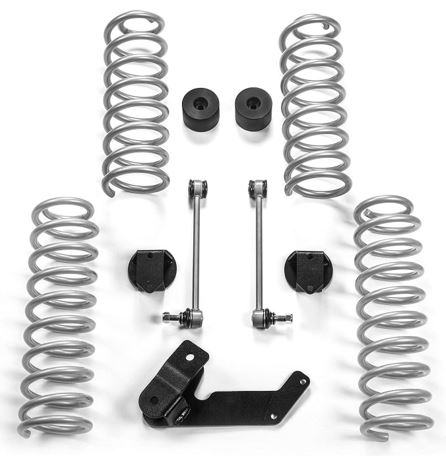
Coil Springs are one of the most significant mechanical component that have a critical role in a vehicle’s suspension systems. The primary function of spring is to absorb various shocks generated by the wheels of the vehicle and not to transfer them to the Chassis. Without the help of Coil Springs vehicle would not be able to absorb the forces, which would result in high stress on chassis, less comfortable ride and poor vehicle control.
Shock Absorber
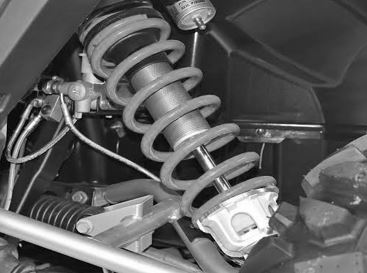
Coil Springs alone are not sufficient in any type of Vehicle because they oscillate for a long time, which is not an efficient, comfortable, etc. so, to avoid such problems, Dampers are used. The Assembly of spring and the damper together forms Shock absorber, which further consists many mechanical components. In a shock absorber, there is a special lubricant or oil known as Shock Absorber Fluid or Oil.
The Shock Absorber Fluid will absorb the spring’s oscillation through the resistance of oil flow in a small hole, which is called as Orifice. When the piston of the Internal Combustion Engine moves in a cylinder contained in the shock absorber, the valve opens when there is a compression and the oil will flow very easy into them to prevent the damping.
Further, the valve will close while expansion of the shock absorber and oil will flow through a small hole which causes damping.
Torsion bar
Torsion bars is a Steel Bar, which uses its twisting properties to provide coil-spring-like performance. The bar is anchored to the Vehicle Frame and the other end is connected to a Wishbone Arm (Wishbone is a type of suspension system). Wishbone Arm acts like a lever that moves perpendicular to the torsion bar.
Torsion Bar also consist few components namely bump, spring, etc. When the wheel hits a bump, vertical motion is transferred to the wishbone and then, to the torsion bar by the levering action. the spring force is generated by twists of torsion bar along its axis.
Sway Bar

Sway Bar is a Metal Rod that joins both the sides of suspension together and provides additional stability to the suspension system in Automobile. The sway bar transfers the movement to the other wheel when the suspension at one wheel moves up or down. The most important feature of Sway Bar is that it resists the roll of the car on its suspension as it corners. Due to this reason, all modern cars are adopting the sway bars.
Wishbone Arms
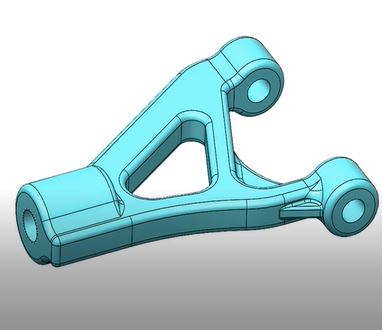
Wishbone Arm is a type of the mechanical linkage, which also consists many mechanical components, where its shape looks like a bird. Further, the pointy end of the wishbone is fastened to the knuckle and the other 2 ends of the Wishbone are fastened to the main frame of the vehicle.
Ball joint

Ball Joint is one of the widely using component, which is a spherical bearing that connects with the Control Arm and Steering Knuckles. Function of a ball joint is to bare various lateral and horizontal loads that a car or vehicle exposed. The ball joint provides rotation axis when the vehicle is turning.
Also Read:
- Otto Cycle – Processes, Internal Combustion Engine, Efficiency, And More
- Diesel Cycle – Its Processes, Working, Efficiency, And More
Types of Suspension System:
As the world is modernized and lots of latest models are introducing into market; there are different types of Suspension System in Automobile. Here we will discuss those different types of suspension.
- Dependant Type of Suspension
- Independent Type of Suspension
Dependant Type of Suspension
If the system of a vehicle in which both the wheels are connected with a solid axle are known as Dependant Type of Suspension. In such type of suspension, the upward motion of one wheel causes slight lift in the other wheel. Leaf Spring Suspension System is very good example of Dependent Type.
Leaf Spring Suspension
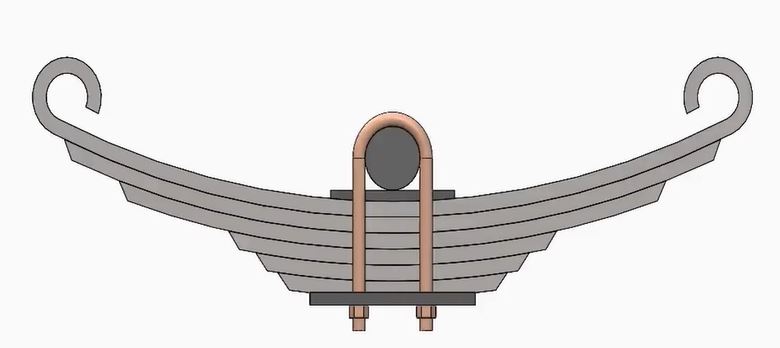
A Leaf Spring Suspension is made up of layers of steel of varying sizes, sandwiched one upon each other. Most of them are Elliptical Shape through the use of spring steel; these are attached in prestressed condition and whenever the load is applied, these springs flex and return to their original position, which we called as Ductility.
Vertical load is distributed throughout the length of the leaf spring whereas; in small coil spring and damper, the forces are concentrated accurately, it can potentially damage the suspension system due to huge amount of force beyond the capability of suspension to handle. The Leaf Spring Suspension is mostly used in the Four-Wheel Drive Vehicles like Cars, Mini Trucks, Lorries, etc.
Independent Type of Suspension
In this type of suspension system, each wheel of the vehicle is independent to move, which results a comparatively smooth riding experience. This type of Suspension further classified into different types based on its Part Configuration and Orientations. They are
- MacPherson Strut
- Double Wishbone Suspension
- Multi-Link Suspension
MacPherson Strut Suspension System
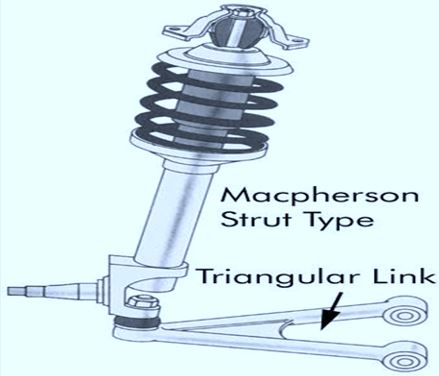
In MacPherson Strut Suspension System, single wishbone control arm is used to connect the car and the wheel hub. The wheel hub in this suspension is the most important pivot point as all parts of the MacPherson strut connects to it and the other end connects with the body of the vehicle. The MacPherson Strut is one of the most common independent Type of suspension that is being used.
Double Wishbone Suspension System and Its Working Video
This type of suspension uses two Wishbone like arms that connected to the wheels. The other part of the wishbone mechanism is almost the same as the MacPherson like coil spring damper etc.
Multi-Link Suspension
This Multi-Link Suspension is derived from the Double Wishbone System, the multi-link suspension uses mechanical components like three or more lateral arms and one or more longitudinal arms, which do not have to be of equal length and can be angled away from their natural direction. The multi-link suspension is seen as the best independent system for a production car because it offers the best compromises between handling, space efficiency and comfort.
Advantages of Types of Suspension System of Automobile
The Advantages of Types of Suspension System of Automobile are
- Leaf Spring setup offers a large amount of support between the wheel, axle and vehicle chassis.
- Heavy vehicles use Leaf Suspension type of system because of its high load bearing capacity
- Independent Type of Suspension gives a Smooth Riding Experience.
- The MacPherson Strut type suspension available in less cost and more effective in usage
- MacPherson Strut Suspension uses comparatively lesser parts, which makes it simpler, and easier to manufacture and has low maintenance.
- The Biggest advantage of Wishbone Suspension System is that it increases its negative chamber due to the movement of wishbone.
- In Double Wishbone System, due to the movement of Wishbone, while at Cornering in high speed, the outside wheel always remains in contact with the road and increases the grip and handling of the vehicle.
Disadvantages of Types of Suspension System
The disadvantages of Types of Suspension System of Automobile are
- MacPherson Strut Suspension is not suitable for high-speed application.
- Due to the complexity of the Multi-Link Suspension System, it is generally used in High End Cars.
Applications of Types of Suspension System
The Applications of Types of Suspension System are
- The Multi-Link Suspension System is mostly used in the Luxury Cars only.
- MacPherson Strut type of suspension is used in the low speed vehicles.
- The Double Wishbone Suspension Type is used in Consumer Four-wheel drive Vehicles and in the Formula Cars, etc.
- Leaf Suspension Type of System is used in the Heavy Load Carrying Vehicles like Lorries, Mini Trucks, etc.
Conclusion:
Each type of suspension has their unique advantages and disadvantages; as the world is well developed and many automobile companies are competing to show their capability in developing the things. Similarly, in the way of modern world, the suspension systems are also important system as they provide better handling and comfort to the rider.
Frequently Asked Questions
What Signs Indicate a Problem with the Suspension System?
A few signs indicates that a problem is raised in the suspension system, they are
- When you apply brakes, your vehicles take nose dive.
- When you drive it down the road, your moves sideward.
- Vehicle drifts when you turn a corner.
- Damper do not move properly.
- Your ride is not smooth.
Why do suspension systems require high maintenance?
Your vehicle’s suspension sustains a lot of wear and tear. When you drive over potholes, hit bumps in the road, crash into the curb, these all take a toll on the suspension. Due to this wear and tear, regular maintenance of suspension system is required.
What are the parts of suspension system?
The parts of suspension systems in automobile are as follows:
- Wishbone Arm
- Coil Springs
- Torsion Bars
- Air Springs
- Ball Joint
- Shock Absorber
Where does the Leaf Spring Suspension System Use?
The Leaf Spring Suspension System is mostly used in the Four Wheeler and More than Four Wheeler Vehicles; such as Cars, Lorries, Heavy Trucks, etc.